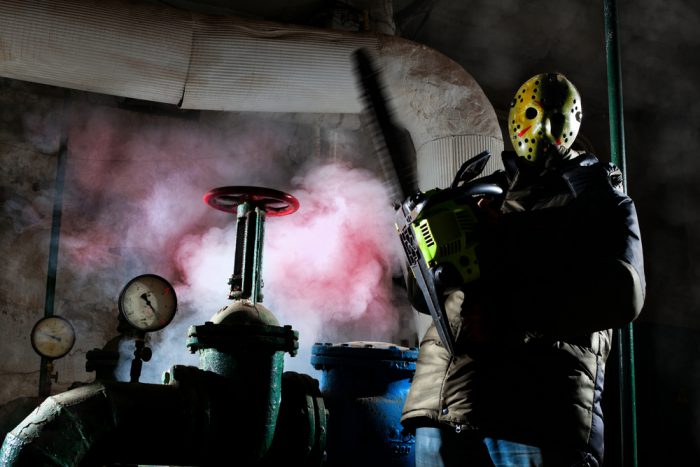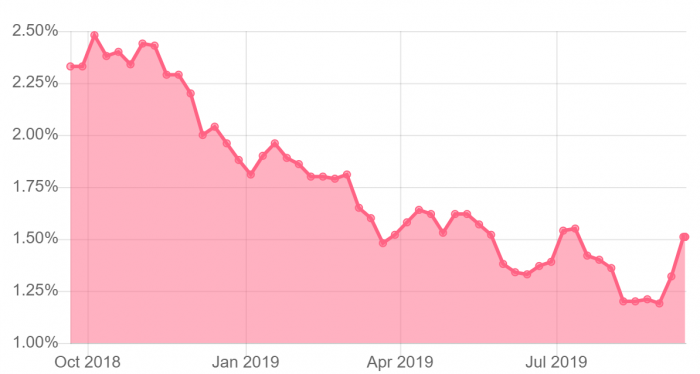Bond Bloodbath
It was a grisly Friday the 13th in the bond market. Investors ran from bonds like they were being chased by Jason Voorhees with a chainsaw.
U.S. 5-year bonds crashed (yields soared 12 bps), which drove Canada’s 5-year to a two-month high. For non-bondy types, bond selling drives up rates since the two move inversely.
Catalysts for the carnage included:
- optimism that the U.S. and China might finally agree to something (what, we don’t know)
- better than expected econ data
- reduced expectations of a Fed rate cut next Wednesday (last month a Fed cut on Sept. 18 was a “certainty,” now it’s just a 79% probability)
- more shoot-first-ask-questions-later selling (partly from traders worried the historic bond rally is ending).
Canada’s 5-year Yield
Those shopping for a fixed mortgage should take heed. The lowest 5-year fixed rates are now just 74 bps above Canada’s 5-year bond—i.e., wildly cheap. A more normal spread between the two is 120-ish (or more) for the best rates and 150-plus-ish (for regular rates).
This is the most competitive September in the mortgage market that we recall in years, however. So, spreads will stay more compressed than usual (and rates more competitive than normal). But some lenders have thrown in the towel and have already started lifting fixed mortgage rates this week, and more will follow.
Three First-Time Home Buyer Incentive (FTHBI) Updates
- Here’s a quick way to estimate your maximum purchase price if you use the FTHBI: Multiply your household income by four and add your down payment. This is what CMHC reps advise when people call in asking for the maximum theoretical purchase price.
- I heard from a (very) high-level industry source today, one that talks to default insurers regularly. He said that through the first 10 days of the First-Time Home Buyer Incentive program, he estimates there have been less than 250 applications across the country. If you extrapolate that, we’re talking less than 33,000 users over the three-year proposed lifespan of the program. The government is estimating 100,000. Mind you, this is just one source and it’s early days. Once consumers are more educated on it, uptake could improve. But if the Liberals want to hit their projections, they better hope they get back into power and can keep this program rolling. As for CMHC, it declined to comment on uptake, citing a required quiet period heading into the election.
- One other thing CMHC confirmed is that “there is no minimum time the owner is required to keep the home…in order to qualify for the [First-Time Home Buyer Incentive]. That means you could plan to flip your owner-occupied home and use the program simply as a taxpayer-funded scheme to lower your default insurance premiums. And those premium savings would be material: $4,000+ on a $400,000 home. CMHC adds, however, that “a person can only receive the incentive once.” So, keep that in mind.
Rate Nuggets
- The OIS market is now pricing in just an 11% chance of a Bank of Canada rate cut on October 30.
- Economists continue to forecast a 1.50% overnight rate (25 bps lower than today) by end of 2020, according to a recent Refinitiv poll.
- Debt service expense is running at 15% of income, reports StatsCan (via FP). That’s the most ever on record.
- Capital Economics economist Neil Shearing says recessions generally have one of six causes: central banks raising interest rates, governments cutting spending, the bursting of a debt bubble, the bursting of a housing bubble, a balance-of-payments crisis or a banking crisis. Canada isn’t facing any of them, yet.

 log in
log in


 Here’s a quick way to estimate your maximum purchase price if you use the FTHBI: Multiply your household income by four and add your
Here’s a quick way to estimate your maximum purchase price if you use the FTHBI: Multiply your household income by four and add your
1 Comment
I wouldn’t hold my breath for the U.S. and China to suddenly start playing nice. Not as long as Trump is in power. I’m betting this rise in yields is short lived.